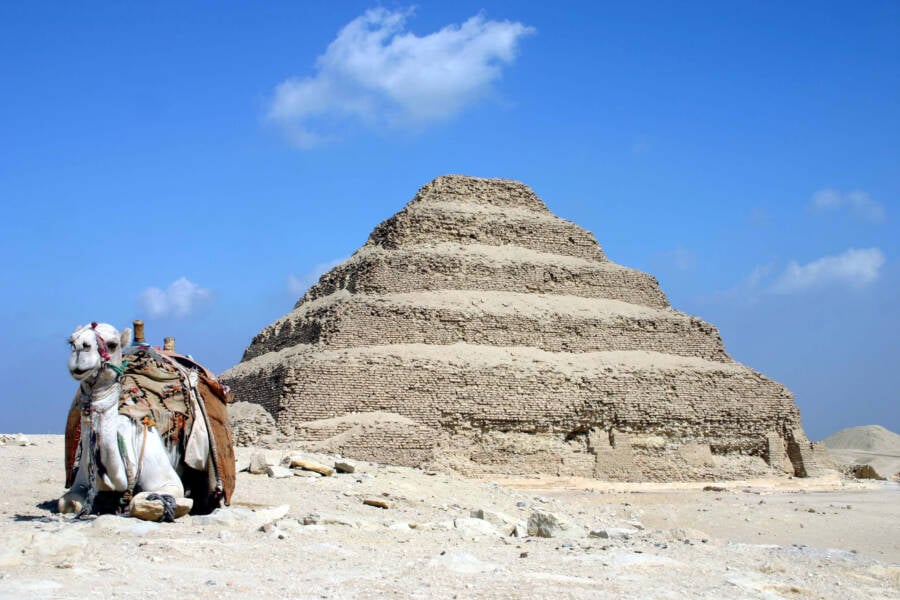Research suggests that ancient Egyptians may have built the Pyramid of Djoser using a hydraulic lift that raised stone blocks up through the center of the structure.

Charles J. Sharp/Wikimedia CommonsThe Pyramid of Djoser is believed to be the first pyramid built in Egypt and was constructed around 4,700 years ago.
New research into the Egyptian pyramids may have unlocked the secret of how they were built. Researchers analyzing the step pyramid erected by the Third Dynasty pharaoh Djoser claim to have discovered a complex water management system that included a hydraulic lift in the middle of the ancient structure.
If so, this would have allowed the tomb to be built “volcano” style, with workers raising limestone blocks through the center of the pyramid and then stacking them into place. If this can be proven true, then it may just finally put to rest the numerous theories of how the pyramids were built in the first place.
The Potential Hydraulic Lift In The Pyramid Of Djoser
In a new study published as a pre-print in PLOS ONE, a team of French engineers, hydrologists, and other experts used satellite radar images and historical reports from archaeologists to try and solve, once and for all, how the first pyramid was built.
Through their analysis, the team found multiple features within and around the Pyramid of Djoser whose exact purpose has long eluded scientists. Now, researchers are suggesting that these features are textbook examples of water management systems.
Before this, the prevailing theory of how the pyramids were built suggested that limestone blocks were dragged over vast lengths of desert as workers poured water on the sand, creating a surface with far less friction. It has also been suggested that these blocks were transported along the Nile River, but both of these theories fail to properly explain how ancient Egyptian laborers actually managed to put the pyramids together.
In the past, experts have suggested they might have used some system of levers and pulleys to raise up the limestone blocks — which would have been an astonishing feat of engineering given that the pyramids were built more than 4,500 years ago. However, it turns out the engineering here may have been even more remarkable.
Speaking with Haaretz, study lead author Dr. Xavier Landreau, an engineer and material scientist, says that satellite imagery clearly shows that a rectangular stone enclosure known as Gisr el-Mudir, which lies immediately west of the Saqqara necropolis where the Pyramid of Djoser stands, has all the technical characteristics of a “check dam.” This would have been used to control the flow of flash floods and capture heavy objects like trees and boulders coming from upriver.
“Anyone familiar with the hydraulic field, even a first-year student, would recognize the profile of a check dam,” he said.
But this dam wasn’t the only part of the possible hydraulic system scientists found.
How Ancient Egyptians May Have Constructed Pyramids Using A Hydraulic System
The Pyramid of Djoser is also surrounded by a dry moat that deepens into a trench to the south of the Saqqara necropolis. As the study’s authors explain: “In the southern section of the moat, we show that the monumental linear rock-cut structure consisting of successive, deep compartments, combines the technical requirements of a water treatment facility: a settling basin, a retention basin, and a purification system.”
The researchers state that the retention basin portion of the trench was connected to the pyramid via underground pipelines that pumped water up through the center of the structure as it was being built.
“The ancient architects likely raised the stones from the pyramid centre in a volcano fashion using the sediment-free water from the Dry Moat’s south section,” the study reads. “Ancient Egyptians are famous for their pioneering and mastery of hydraulics through canals for irrigation purposes and barges to transport huge stones. This work opens a new line of research: the use of hydraulic force to erect the massive structures built by Pharaohs.”
If what the authors propose is true, it would offer one of the most robust explanations for how the pyramids were built thus far — and highlight just how advanced the systems used by the ancient Egyptians truly were.
After reading about this new study into how the pyramids were built, learn more about the Nubian pyramids of Sudan. Then, go inside the fascinating history of the Great Pyramid of Cholula.





